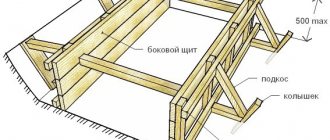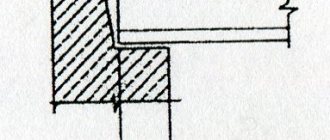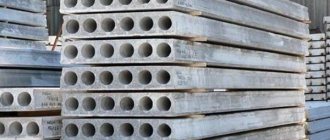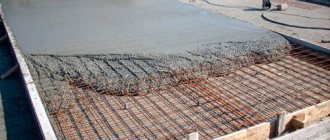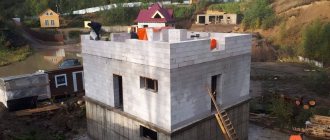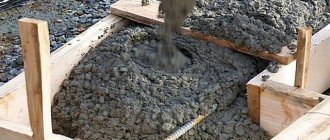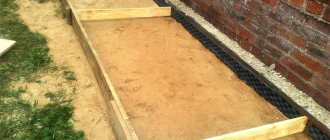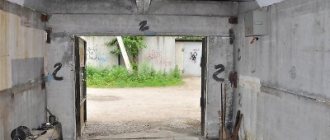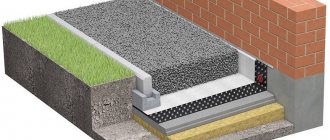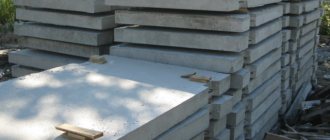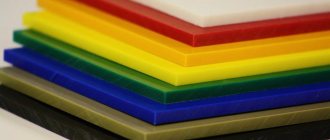The impact on reinforced concrete structures of high and low temperatures, variable freezing and thawing cycles, dynamic loads, and design errors cause corrosion of the reinforcement frame, destruction of the protective layer and a decrease in load-bearing capacity and reduced service life. Concrete repair helps to cope with existing problems and ensure the durability and strength of structures. helps restore structures:
- with insufficient concrete density;
- when reinforcement is exposed, delamination, or cracks appear;
- when the structure deviates from the design dimensions.
Order the service by phone ✆
Concrete restoration begins with diagnostics. The examination allows you to detect weak points, develop a repair strategy, and select the right materials and technologies. The compositions used provide high strength and short setting times.
When repairing concrete, we often use methods such as shot concrete and injection.
In what cases is it necessary to repair concrete products and structures?
Taking into account the experience of inspecting and operating various structures and buildings made of concrete (both recently constructed and old), we can confidently say that there are quite a lot of them in need of repair. This is due to a variety of reasons: from improper design and the inability of the monolith to withstand the impact loads to expiration of the shelf life or destruction as a result of accidents and weather elements.
Not all defects and damage require the complete destruction of the concrete stone and the construction of a new facility. In many cases, it is enough to simply repair the structure correctly in order to successfully maintain all its technical characteristics and significantly extend its service life, guaranteeing strength and reliability.
A defect in a building structure is its non-compliance with the requirements of design/regulatory documentation. Defects may appear during construction on site or during the production of an element in a factory (in this case, we are talking about errors in the design or a violation of the technology for implementing the work).
For example, defects of this type are observed in reinforced concrete structures - these are shrinkage cracks, cavities, which are caused by non-compliance with the pouring and drying technology. If the defects are too serious, they negatively affect the load-bearing capacity downward and cause other problems.
In addition, defects can appear during operation under the influence of external factors and negative influences.
Example: damage to reinforced concrete products in the form of chips from impacts, reducing the service life of the structure and its load-bearing capacity. Often there is exposed reinforcement, which is also dangerous - the metal corrodes, deforming the concrete.
If, after research and calculations, it becomes clear that the structure or building can still serve, you just need to fix the problems and strengthen some components, repair concrete surfaces, protect reinforcement, etc., these are justified actions. As a result, the work is cheaper than replacing a building/element with a full cycle of work.
Types of damage to reinforced concrete
Damage to reinforced concrete is divided into four main types:
- Changes in the density characteristics of concrete - over time, under the influence of a number of external factors, large pores in concrete expand, defects and microcracks form, which leads to a change in the structure of concrete.
- Detachment of the protective coating – cavities and cracks form on the surface layer of concrete.
- Cracks that affect deep layers of concrete - a similar problem is observed if during construction the technology of pouring the concrete solution was violated, due to which the bond between the layers does not have a sufficient level of strength.
- Excessive load of individual structural elements - even at the design stage, an error was made regarding the base and the structure itself, as a result of which there may be deflections, cracks, chips, and corrosion of the reinforcement frame in the concrete.
Depending on what kind of damage exists (determined by specialists using special equipment), concrete repair technology, materials and equipment are selected.
Modern materials for repairing concrete products
It is not worth restoring concrete and repairing it with a regular cement-sand mixture. The repair solution must provide maximum characteristics of strength, reliability, adhesion, plasticity, thixotropy, since in this case the design is not simply created using technology, but errors, defects are eliminated, knots are connected, there is exposure to increased loads, etc.
If we consider domestic manufacturers of universal mixtures that can be used to repair and protect concrete, then Penetron-Russia materials are considered the best on the market. The most popular compositions are “Skrepa M700 Structural” and “Skrepa M500 Repair”.
Main properties and advantages of these materials:
- Minimum setting time.
- High level of compressive strength, which is ensured already in the early stages.
- Thixotropy, plasticity, workability.
- High levels of frost resistance, water resistance, and wear resistance.
- Good adhesion to concrete.
- Durability and corrosion resistance.
- Complete absence of shrinkage.
Due to these properties, the repaired and restored section of the structure, after quick setting, immediately begins to work along with the other parts of the monolith as a single whole. In the shortest possible time, the original load-bearing capacity is restored, which allows the structures to continue to be used without the need for dismantling and replacement.
The structural composition demonstrates higher performance and values, therefore it is used in the most severe cases and critical structures. So, for example, the material is used in work with bridge spans. The composition makes it possible to restore the geometric shape of structures even in the presence of serious damage and defects.
The scope of application of these two solutions covers almost all areas of construction: they are used to repair structures and structures for various purposes (including bridges, cooling towers, tunnels, oil product storage facilities, sewage treatment plants, water storage tanks, concrete docks, emergency and civil defense structures, and etc.).
In private construction and repair of unloaded structures, mortars mixed on the basis of high-strength cement with special complex additives are often used; fiber-reinforced concrete, polymer solutions, quick-hardening cements, etc. are also relevant. The most important task is to ensure the desired structural characteristics and achieve high adhesion between the main structure and the repaired area.
Techniques can be used to enhance the bond between old/new concrete. If there is significant damage to the surface, the base is filled with new concrete, having previously cleaned the area to a durable monolith.
Ordinary heavy concrete is suitable for partial/full repair of structures, when applying repair compounds in a layer of more than 10 centimeters, in pouring solid reinforced concrete jackets.
The area that needs to be concreted again is buried and made of sufficient thickness. It is advisable to reinforce it with steel mesh by shooting it to the base with dowels or firmly fastening it by other methods. Old concrete is thoroughly cleaned and washed, exposing the filler grains and making the surface rough. An additional layer can also be made to increase adhesion (cement adhesives, epoxy compositions, polymer acrylics and others).
Main types of repair compounds:
- Dry mixes (BIRSS, Knauf, Osnovit, Emaco) - are prepared on the basis of cement, are compatible with concrete, and allow for high-quality repair of any structure. The thickness of the repair layer per application can be 5-50 millimeters for horizontal/vertical bases, on the ceiling - up to 30 millimeters. Works best with primers and primers. Suitable for structural repairs of concrete/reinforced concrete structures at temperatures above +5 degrees, they protect and waterproof. They are used for sealing defects, expedited repairs, and in the repair of industrial floors and road surfaces, joints. Advantages: maximum adhesion and compressive strength, no shrinkage, ability to eliminate defects up to 10 centimeters deep, speed. Disadvantages: high cost, short shelf life.
- Thixotropic compositions (BASF, MAPEI, Sika) are dry mixtures made on the basis of high-strength cement and fractionated sand, and special additives. The most effective are compositions with polymer fiber. The composition can be used without formwork on horizontal, vertical, ceiling planes. After hardening, it turns into high-strength concrete and can be applied in layers up to 35 millimeters. Used for repairing precast/monolithic concrete, bridges, viaducts, tunnels, canals, protective layers, joints, objects for various purposes. Pros: wear resistance, high adhesion, water resistance, frost resistance. Disadvantages: can only be used at positive temperatures, high cost.
- Mixtures based on epoxy resins and other polymers (Technoplast, Elakor, KrasKO) are used in various types of repairs and are relevant for injection to protect concrete from various influences. Elastic, semi-rigid, rigid compounds are used in the work. For polymers, concrete must be prepared and primed. The products are applied using polyamide rollers or a smooth spatula; it is also possible to use special equipment (injection method). The compounds seal chips and cracks and increase water resistance and strength. Two-component mixtures are used to restore load-bearing capacity, repair cracks, create an adhesive layer, localize leaks, etc. Pros: good mechanical/chemical resistance, fire safety, high adhesion, waterproofing. Cons: low viability.
- Repair and secondary waterproofing of concrete (Protexil, SCHOMBURG) - used to protect structures and elements from operating conditions. There are two types: hydrophobic impregnations (silaxane, silane, polysilaxane) to act on the surface and give it water-repellent properties, as well as polymer- and mineral-based impregnations to strengthen and reduce the porosity of the stone.
Cost of restoration and repair
The cost of restoration and repair of concrete structures directly depends on the complexity of the task, volume, problem, materials used and other factors. The price is based on a calculation of the square meters of the structure that need to be repaired or restored. Usually the cost is lower, the more m2 you need to restore.
Possible types of work: removal of a defective/damaged layer of concrete to a certain depth (the deeper, the more expensive), cleaning of rust from reinforcement, restoration of the protective layer of a concrete monolith, waterproofing of junctions, joints between blocks, cold seams, cracks, waterproofing of prefabricated and monolithic structures, installation of grooves and filling them with repair composition and other types of work.
Much depends on the region - for example, work in Moscow can be much more expensive than in the regions due to different wages, the cost of renting premises, materials, etc.
If you do all the work yourself, then the price consists only of the cost of materials and the time spent on completing the task. It is also advisable to first carry out a design for the structure to be restored, carefully calculate everything, determine the feasibility of repair procedures, and ensure the effectiveness of the chosen method and composition.
Restoring the protective layer of concrete
Fastening the reinforcing mesh with knitting wire 7. Quality control of materials and repair work 8. Occupational health and safety Appendix 1.
Requirements for the operation of a set of equipment for the repair of artificial structures RDA Fig. Schematic diagram of equipment for shotcrete Fig. Search in the text. General provisions 1. Classification of repair work 2. Repair work on concrete surfaces of elements of operating bridges are divided into six groups: I - prevention of destruction of the protective layer of concrete; elimination of peeling of concrete surfaces damaged to a depth of mm; routine repairs; II - repair of the surface of the protective layer damaged to a depth of up to 10 mm; current repair; III - restoration of the protective layer destroyed to a depth of up to 30 mm; average repair; IV - restoration of the protective layer and partially the concrete of the structure, if necessary, with reinforcement; medium repair; V - repair of areas damaged mechanically or as a result of poor quality workmanship of the structure - sinks, chips with exposed reinforcement; average repair; VI - preventive work to prevent damage to surfaces.
Types of repair work and scope of their application 3. Table 3. I Initial stage of concrete damage, peeling: a facade and upper surfaces of paving blocks Insufficient density, frost resistance of concrete Hydrophobization; hydrophobization, duplicated with paint and varnish coatings and epoxy enamel I b facade surfaces of reinforced concrete beams of spans with frame reinforcement Constant wetting of the surface, insufficient density The same in the surface of the middle beams of spans, crossbars and support bodies Insufficient density frost resistance of concrete Hydrophobization, latex cement coatings 2.
I Local peeling of the surfaces of beams of spans in the overhead zone Constant wetting and contamination of surfaces due to faulty expansion joints Duplicate coatings 3. I Peeling of the concrete surface of curbs or fences Insufficient density of concrete The same 4.
